What'sNEW October–December 2008
 24 December 2008 24 December 2008
Retroviral genome invasions—whereby retroviruses infect germ line cells, causing integrated proviral sequences to be inherited as host alleles termed 'endogenous retroviruses' (ERVs)—have occurred throughout the evolution of vertebrates and continue to the present day.
 Robert J. Gifford et al., "A transitional endogenous lentivirus from the genome of a basal primate and implications for lentivirus evolution" [Open Access abstract], doi:10.1073/pnas.0807873105, p 20362-20367 v 105, Proc. Natl. Acad. Sci. USA, 23 Dec 2008. "...Demonstrating that lentiviruses are capable of invading the primate germ line.... primate lentiviruses may be considerably older and more broadly distributed than previously thought." Robert J. Gifford et al., "A transitional endogenous lentivirus from the genome of a basal primate and implications for lentivirus evolution" [Open Access abstract], doi:10.1073/pnas.0807873105, p 20362-20367 v 105, Proc. Natl. Acad. Sci. USA, 23 Dec 2008. "...Demonstrating that lentiviruses are capable of invading the primate germ line.... primate lentiviruses may be considerably older and more broadly distributed than previously thought."
 Viruses... is the main related CA webpage [ Viruses... is the main related CA webpage [ What'sNEW about HGT What'sNEW about HGT  ] ]
 23 December 2008 23 December 2008
Maybe heat-loving prokaryotes are not the oldest form of life. This is the conclusion of French and Canadian biologists using new "heterogeneous" computer programs to compare ribosomal RNA and amino acid sequences from all domains of life. They conclude that the last universal common ancestor (LUCA) evolved in moderate temperatures, and that prokaryotes descending from it became heat-loving only later. This is good news for RNA World theories, because RNA is particularly sensitive to heat and is unlikely to be stable in the hot temperatures of the early Earth, they note.
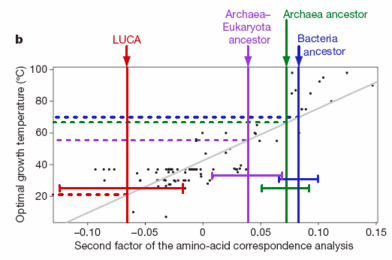 Our research is much like studying the etymology of modern languages so as to reveal fundamental things about their evolution. ...We identified common genetic traits between animals, plant, bacteria, and used them to create a tree of life with branches representing separate species. These all stemmed from the same trunk – LUCA, the genetic makeup that we then further characterized, says research team member Nicolas Lartillot.
Our research is much like studying the etymology of modern languages so as to reveal fundamental things about their evolution. ...We identified common genetic traits between animals, plant, bacteria, and used them to create a tree of life with branches representing separate species. These all stemmed from the same trunk – LUCA, the genetic makeup that we then further characterized, says research team member Nicolas Lartillot.
Research like this is highly inferential, and can be confounded by gene transfer and gene loss. The research team is aware of that problem and claims to have excluded it, but ancient transfers may be impossible to detect. More interesting to us were several other aspects of the report —
- ...A non-hyperthermophilic LUCA would suggest that moderate temperatures existed earlier in the history of the Earth. — These scientists are willing to let a biological inference contribute to our thinking about the history of our planet. Usually biology is treated a subordinate to nonbiological subjects. (This subordination is especially noteworthy, and likely misleading, regarding cosmology.)
- Alternatively, under the hypothesis that life originated extra-terrestrially, the transfer of life to the Earth from another planet in ejecta created by meteorite impacts would have also entailed selection of heat-resistant cells. — They're willing to consider panspermia!
- A biological hypothesis ...posits that the LUCA had an RNA genome, and that its offspring lineages independently evolved the ability to use DNA for genome encoding, possibly by co-opting it from viruses. — Wow, they're willing to consider that horizontal gene transfer (HGT) from viruses could have a role of this magnitude!
Although these biologists are faithful to darwinism, their report gives clear signs of shifting paradigms. This is especially evident in the last bullet point. How viruses could acquire and conserve DNA — before there were cells — is absolutely inexplicable within darwinism. But viruses with genetic programs that are ready for use in life are a basic prediction of cosmic ancestry.
 Bastien Boussau et al., "Parallel adaptations to high temperatures in the Archaean eon" [abstract], doi:10.1038/nature07393, p 942-945 v 456, Nature, 18-25 Dec 2008. Bastien Boussau et al., "Parallel adaptations to high temperatures in the Archaean eon" [abstract], doi:10.1038/nature07393, p 942-945 v 456, Nature, 18-25 Dec 2008.
 "Genomic clues settle debate about ancestor of all life forms" [html], doi:10.1038/7224xviia, p xvii v 456 n 7224, Nature, 18-25 Dec 2008. "Genomic clues settle debate about ancestor of all life forms" [html], doi:10.1038/7224xviia, p xvii v 456 n 7224, Nature, 18-25 Dec 2008.
 Earth's original ancestor was LUCA, not Adam nor Eve, University of Montreal (also Physorg.com, with discussion), 17 Dec 2008. Earth's original ancestor was LUCA, not Adam nor Eve, University of Montreal (also Physorg.com, with discussion), 17 Dec 2008.
 Viruses... is the main CA webpage about HGT [ Viruses... is the main CA webpage about HGT [ What'sNEW about HGT What'sNEW about HGT  ] ]
 The RNA World is a related CA webpage. The RNA World is a related CA webpage.
 Testing Darwinism versus Cosmic Ancestry is a CA webpage where we discuss this method of analysis. Testing Darwinism versus Cosmic Ancestry is a CA webpage where we discuss this method of analysis.
 Is Sustained Macroevolutionary Progress Possible? is a CA webpage a suggesting role reversal — cosmology may have to accommodate a fundamental biological principle. Is Sustained Macroevolutionary Progress Possible? is a CA webpage a suggesting role reversal — cosmology may have to accommodate a fundamental biological principle.
 The End and the Big Bang is a CA webpage promoting a major role for biology in cosmology. The End and the Big Bang is a CA webpage promoting a major role for biology in cosmology.
 Thanks, Stan Franklin, Bob Sweeney and Jeff Holiman. Thanks, Stan Franklin, Bob Sweeney and Jeff Holiman.
 21 December 2008 21 December 2008
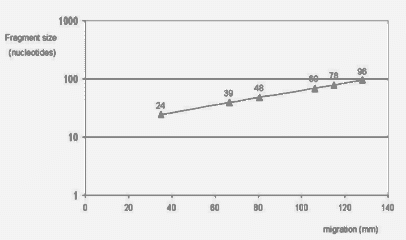 How ancient organic molecules came together to form the basis of life — According to a press release, this is the issue illuminated by recent research with RNA molecules at the Department of Genetics and Molecular Biology, Sapienza University of Rome, Italy. A team there showed that under certain conditions RNA molecules could be induced to grow longer than they normally do in solution. Obtaining strands of RNA nucleotides long enough to have any biological function is one of the difficulties for "RNA World" versions of origin-of-life theories. If that difficulty can be overcome, RNA strands long enough to fold might happen to acquire enzymatic properties, the Italians suppose.
How ancient organic molecules came together to form the basis of life — According to a press release, this is the issue illuminated by recent research with RNA molecules at the Department of Genetics and Molecular Biology, Sapienza University of Rome, Italy. A team there showed that under certain conditions RNA molecules could be induced to grow longer than they normally do in solution. Obtaining strands of RNA nucleotides long enough to have any biological function is one of the difficulties for "RNA World" versions of origin-of-life theories. If that difficulty can be overcome, RNA strands long enough to fold might happen to acquire enzymatic properties, the Italians suppose.
Having studied the complete report, we think the research demonstrates far less than the opening quote suggests. To begin with, the experimental environment required laboratory conditions that would never exist in nature, such as "commercial distilled water ...further purified by tridistillation-deionization." And the needed RNA molecules were simply supplied. But these are made biologically, and never found in sufficient concentrations in lifeless environments.
There are, of course, very many other obstacles facing origin-of-life theories. Most importantly, life requires strands of nucleotides with encoded, programmatic meaning. The RNA strands in the Italian project have no prospect of acquiring such meaning. Therefore it is premature to suggest that they might "form the basis of life."
 Samanta Pino et al., "Nonenzymatic RNA Ligation in Water" [abstract], doi:10.1074/jbc.M805333200, p 36494-36503 v 283, J. Biol. Chem., 26 Dec 2008. "Ligation of short RNA fragments could have liberated the prebiotic polymerization systems from the thermodynamically demanding task of reaching a (pre)genetically meaningful size by stepwise addition of one precursor monomer at the time." Samanta Pino et al., "Nonenzymatic RNA Ligation in Water" [abstract], doi:10.1074/jbc.M805333200, p 36494-36503 v 283, J. Biol. Chem., 26 Dec 2008. "Ligation of short RNA fragments could have liberated the prebiotic polymerization systems from the thermodynamically demanding task of reaching a (pre)genetically meaningful size by stepwise addition of one precursor monomer at the time."
 A simple fusion to jump-start evolution, EurekAlert!, 18 Dec 2008. A simple fusion to jump-start evolution, EurekAlert!, 18 Dec 2008.
 The RNA World is the main CA webpage about origin-of-life theories. The RNA World is the main CA webpage about origin-of-life theories.
 Residue from one of Stanley Miller's experiments — compare the controlled environment in the Italian experiment to the volcanic plume recently advocated by Miller's disciples, What'sNEW, 20 Oct 2008 Residue from one of Stanley Miller's experiments — compare the controlled environment in the Italian experiment to the volcanic plume recently advocated by Miller's disciples, What'sNEW, 20 Oct 2008
 Thanks, Stan Franklin. Thanks, Stan Franklin.
 Giovanna Costanzo et al., "Generation of long RNA chains in water" [abstract], doi:10.1074/jbc.M109.04, J. Biol. Chem., online 2 Oct 2009. Giovanna Costanzo et al., "Generation of long RNA chains in water" [abstract], doi:10.1074/jbc.M109.04, J. Biol. Chem., online 2 Oct 2009.
 9 December 2008 9 December 2008
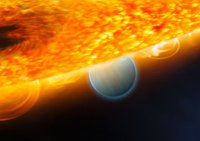 Organic compounds can also be a by-product of life processes and their detection on an Earth-like planet may someday provide the first evidence of life beyond Earth. These comments come from the science team operating the Hubble Space Telescope, whose recent observations include the detection of methane and carbon dioxide in the atmosphere of an extra-solar planet designated HD 189733b. We are pleased by the acknowledgement that organic compounds beyond Earth may be post-biotic, a possibility usually ignored. Organic compounds in space have been well-known for decades now. Could the "first evidence" already be in hand? Meanwhile, another team, using NASA's Spitzer Space Telescope, has seen water vapor on the same planet.
Organic compounds can also be a by-product of life processes and their detection on an Earth-like planet may someday provide the first evidence of life beyond Earth. These comments come from the science team operating the Hubble Space Telescope, whose recent observations include the detection of methane and carbon dioxide in the atmosphere of an extra-solar planet designated HD 189733b. We are pleased by the acknowledgement that organic compounds beyond Earth may be post-biotic, a possibility usually ignored. Organic compounds in space have been well-known for decades now. Could the "first evidence" already be in hand? Meanwhile, another team, using NASA's Spitzer Space Telescope, has seen water vapor on the same planet.
 Hubble finds carbon dioxide on an extrasolar planet, News Release - heic0823, NASA/ESA Hubble Space Telescope, 9 Dec 2008. Hubble finds carbon dioxide on an extrasolar planet, News Release - heic0823, NASA/ESA Hubble Space Telescope, 9 Dec 2008.
 "Distant world sports gassy signature of habitability" [html], doi:10.1038/456435b, p 435 v 456, Nature, 27 Nov 2008. "Distant world sports gassy signature of habitability" [html], doi:10.1038/456435b, p 435 v 456, Nature, 27 Nov 2008.
 Carl J. Grillmair et al., "Strong water absorption in the dayside emission spectrum of the planet HD 189733b" [abstract], doi:10.1038/nature07574, p 767-769 v 456, Nature, 11 Dec 2008. Carl J. Grillmair et al., "Strong water absorption in the dayside emission spectrum of the planet HD 189733b" [abstract], doi:10.1038/nature07574, p 767-769 v 456, Nature, 11 Dec 2008.
 Drake Deming, "...Quest for a habitable world" [html], doi:10.1038/456714a, p 714-715 v 456, Nature, 11 Dec 2008. Drake Deming, "...Quest for a habitable world" [html], doi:10.1038/456714a, p 714-715 v 456, Nature, 11 Dec 2008.
 Methane and water, but no carbon monoxide — an earlier What'sNEW article about this same planet, 22 Mar 2008. Methane and water, but no carbon monoxide — an earlier What'sNEW article about this same planet, 22 Mar 2008.
 Life on Europa, Other Moons, Other Planets? is a related CA webpage. Life on Europa, Other Moons, Other Planets? is a related CA webpage.
 Hoyle and Wickramasinghe's Analysis of Interstellar Dust is a related CA webpage. Hoyle and Wickramasinghe's Analysis of Interstellar Dust is a related CA webpage.
 1 December 2008 1 December 2008
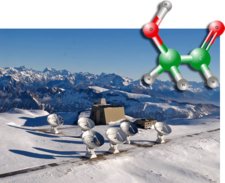 Glycolaldehyde 26,000 light-years away has been detected by European astronomers using the IRAM radio dish array in France. Glycolaldehyde is a simple sugar that makes up ribose, one of the constituents of RNA. Finding it in a coalescing disk of dust and gas in a star-forming region of space was a surprise. "The sugar molecule can apparently form in a simple reaction between carbon monoxide molecules and dust grains," reports Phil Berardelli in Science. This is especially interesting, he adds, because the phenomenon was observed "far away from the radiation-filled center of the Milky Way, so if any biological processes start up there, they will have a chance to establish themselves."
Glycolaldehyde 26,000 light-years away has been detected by European astronomers using the IRAM radio dish array in France. Glycolaldehyde is a simple sugar that makes up ribose, one of the constituents of RNA. Finding it in a coalescing disk of dust and gas in a star-forming region of space was a surprise. "The sugar molecule can apparently form in a simple reaction between carbon monoxide molecules and dust grains," reports Phil Berardelli in Science. This is especially interesting, he adds, because the phenomenon was observed "far away from the radiation-filled center of the Milky Way, so if any biological processes start up there, they will have a chance to establish themselves." Organic compounds in space are now well-known. The consensus is that they are pre-biotic. But if glycolaldehyde can be made nonbiologically from carbon monoxide and dust, howcome we didn't already know that? We suggest that the observed organics might be post-biotic. Seeing them in a life-friendly part of the galaxy only strengthens this possibility.
 Most Planets May Be Seeded With Life, by Phil Berardelli, ScienceNOW Daily News, 26 Nov 2008. Most Planets May Be Seeded With Life, by Phil Berardelli, ScienceNOW Daily News, 26 Nov 2008.
 Hoyle and Wickramasinghe's Analysis of Interstellar Dust is a related CA webpage. Hoyle and Wickramasinghe's Analysis of Interstellar Dust is a related CA webpage.
 Thanks, Stan Franklin. Thanks, Stan Franklin.
 27 November 2008 27 November 2008
The discovery answers an age-old question that has puzzled biologists since the time of Darwin: How can organisms be so exquisitely complex, if evolution is completely random, operating like a 'blind watchmaker'? ...Our new theory extends Darwin's model, demonstrating how organisms can subtly direct aspects of their own evolution to create order out of randomness.

During evolution, the potential "bangs" from its lower and upper accessible values at critical times where effective mutations have occurred. |
These are the comments of chemist Raj Chakrabarti, promoting recent research by his team at Princeton University. They artificially mutated enzymes that are components of the mitochondrial electron transport chain (ETC), without which cells would die. The chemists found that swapping a few residues altered the strength of the enzymes not gradually, as expected, but drastically, between the lowest and highest obtainable values. They call this "bang-bang control behavior."The published report states "...Within this conserved protein architecture, a range of variation in redox potential ...of about 160 mV could be obtained within two rounds of (reverse) evolution, involving only four residues. Statistical analysis ...indicates that this range represents, with >75% confidence, the total range accessible through mutations at these positions."
The researchers reasoned that such an optimal control system would enable darwinian mutation and natural selection to find the best enzymatic configuration quickly. The research is highly technical, and the described control behavior is definitely interesting. Importantly, the experiments explore a method for the re-optimization of enzymatic functions that already exist. Optimization of existing functions is a capability of darwinian evolution that is not in doubt. The published report has nothing to say about a more controversial and important issue, the invention of new functions.
But Chakrabarti's promotional comments quoted in bold above, posted online by the Princeton News Office and widely distributed, give a very different impression. To begin with, if biologists have been puzzled since the time of Darwin by an age-old question, that puzzlement was not well-advertised. But nevermind, because the puzzle has been solved. Now the blind watchmaker's ability to make organisms so exqusitely complex is demonstrated even better than before. Or so we are invited to believe. The research actually demonstrates much less than these claims. Such exaggeration is not unusual when the researchers themselves are the ones explaining their results. And a campus news office will only report what the academic departments tell it. We wish an informed and sceptical press corps would play a bigger role, as in politics, for example. The interested public deserves not to be misled about science.
 Raj Chakrabarti et al., "Mutagenic Evidence for the Optimal Control of Evolutionary Dynamics" [login link], doi:10.1103/PhysRevLett.100.258103, v 100, Physical Review Letters, 27 Jun 2008. Raj Chakrabarti et al., "Mutagenic Evidence for the Optimal Control of Evolutionary Dynamics" [login link], doi:10.1103/PhysRevLett.100.258103, v 100, Physical Review Letters, 27 Jun 2008.
 Evolution's new wrinkle: Proteins with cruise control provide new perspective, by Kitta MacPherson, News at Princeton, 10 Nov 2008. Evolution's new wrinkle: Proteins with cruise control provide new perspective, by Kitta MacPherson, News at Princeton, 10 Nov 2008.
 Neo-Darwinism: The Current Paradigm is a related CA webpage. Neo-Darwinism: The Current Paradigm is a related CA webpage.
 Thanks, Gregor Kervina. Thanks, Gregor Kervina.
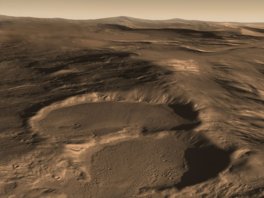
 26 November 2008 26 November 2008
Huge glaciers buried under debris have been detected at low latitudes on Mars by means of ground-penetrating radar from NASA's Mars Reconnaissance Orbiter.
 John W. Holt et al., "Radar Sounding Evidence for Buried Glaciers in the Southern Mid-Latitudes of Mars" [abstract], p 1235-1238 v 322, Science, 21 Nov 2008. John W. Holt et al., "Radar Sounding Evidence for Buried Glaciers in the Southern Mid-Latitudes of Mars" [abstract], p 1235-1238 v 322, Science, 21 Nov 2008.
 Henry Fountain, "Blanket of Soil May Hide Vast Martian Glaciers" [link], p D3, The New York Times, 25 Nov 2008. Henry Fountain, "Blanket of Soil May Hide Vast Martian Glaciers" [link], p D3, The New York Times, 25 Nov 2008.
 Radar Indicates Buried Glaciers on Mars, Astronomy Picture of the Day, 24 Nov 2008. Radar Indicates Buried Glaciers on Mars, Astronomy Picture of the Day, 24 Nov 2008.
 Buried Mars Glaciers May Be Remnants of Past Ice Age, by Anne Minard, National Geographic News, 20 Nov 2008. Buried Mars Glaciers May Be Remnants of Past Ice Age, by Anne Minard, National Geographic News, 20 Nov 2008.
 Life on Mars! is a related CA webpage. Life on Mars! is a related CA webpage.
 Thanks, Barbara Wade. Thanks, Barbara Wade.
 25 November 2008 25 November 2008
The Cosmic Ancestry website has a new hosting company, pair.com. We hope access and response time will be better.
 About This Website is a related CA webpage. About This Website is a related CA webpage.
 20 November 2008 20 November 2008
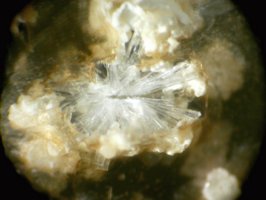 Life has a role in the origin of minerals according to geophysicist Robert Hazen of the Carnegie Institution. Thousands of minerals can form only in special environments that are produced by life. Many of them, like azurite and malachite, require an oxygen-rich atmosphere. Of the approximately 4,300 known mineral species on Earth, perhaps two thirds of them are biologically mediated. This is principally a consequence of our oxygen-rich atmosphere, which is a product of photosynthesis by microscopic algae, Hazen's team reports.
Life has a role in the origin of minerals according to geophysicist Robert Hazen of the Carnegie Institution. Thousands of minerals can form only in special environments that are produced by life. Many of them, like azurite and malachite, require an oxygen-rich atmosphere. Of the approximately 4,300 known mineral species on Earth, perhaps two thirds of them are biologically mediated. This is principally a consequence of our oxygen-rich atmosphere, which is a product of photosynthesis by microscopic algae, Hazen's team reports.
Some of these minerals from living environments can persist unchanged for billions of years, providing a way to detect very ancient life. We wonder, are any life-influenced minerals to be found in meteorites?
 Robert Hazen et al., "Mineral evolution" [abstract.pdf], p 1693-1720 v 93, American Mineralogist, Nov-Dec 2008. Robert Hazen et al., "Mineral evolution" [abstract.pdf], p 1693-1720 v 93, American Mineralogist, Nov-Dec 2008.
 Minik T. Rosing, "...On the evolution of minerals" [html], doi:10.1038/456456a, p 456-457 v 456, Nature, 27 Nov 2008. Minik T. Rosing, "...On the evolution of minerals" [html], doi:10.1038/456456a, p 456-457 v 456, Nature, 27 Nov 2008.
 Crisogono Vasconcelos and Judith A. McKenzie, "The Descent of Minerals" [link], doi:10.1126/science.1168807, p 218-219 v 323, Science, 9 Jan 2009. Crisogono Vasconcelos and Judith A. McKenzie, "The Descent of Minerals" [link], doi:10.1126/science.1168807, p 218-219 v 323, Science, 9 Jan 2009.
 Mineral kingdom has co-evolved with life, Carnegie Institution of Washington, 13 Nov 2008. [Robert Hazen interview.mov] Mineral kingdom has co-evolved with life, Carnegie Institution of Washington, 13 Nov 2008. [Robert Hazen interview.mov]
 Earth's Minerals Evolved, Too, by Phil Berardelli, ScienceNOW Daily News, 14 Nov 2008. Earth's Minerals Evolved, Too, by Phil Berardelli, ScienceNOW Daily News, 14 Nov 2008.
 Microbes drove Earth's mineral evolution, doi:10.1038/news.2008.1226, by Ashley Yeager, NatureNews, 14 Nov 2008. Microbes drove Earth's mineral evolution, doi:10.1038/news.2008.1226, by Ashley Yeager, NatureNews, 14 Nov 2008.
 Gaia is a related CA webpage. Gaia is a related CA webpage.
 18 November 2008 18 November 2008
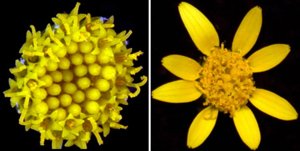 ...Borrowing a couple of genes.... challenges the notion that higher organisms must rely on their own genes to evolve. These comments follow an investigation asking how a hybrid of the British common groundsel weed (pictured) came to have its large yellow petals (right). The international team determined that the change was initiated when the groundsel's ancestor acquired a cluster of regulatory genes from a Sicilian species introduced some 300 years ago. The transfer likely resulted from cross-pollenation. The biologists write, Our results ...show how gene transfers between species may play an important part in the evolution of key ecological and morphological traits.
...Borrowing a couple of genes.... challenges the notion that higher organisms must rely on their own genes to evolve. These comments follow an investigation asking how a hybrid of the British common groundsel weed (pictured) came to have its large yellow petals (right). The international team determined that the change was initiated when the groundsel's ancestor acquired a cluster of regulatory genes from a Sicilian species introduced some 300 years ago. The transfer likely resulted from cross-pollenation. The biologists write, Our results ...show how gene transfers between species may play an important part in the evolution of key ecological and morphological traits.
These biologists believe that this example is noteworthy because the identity of the transfered genes and their source are unusually well established. This establishment was easier because the events were relatively recent. And that the transferred genes are regulatory ones is well worth knowing. But documented examples of horizontal gene transfer (HGT) among eukaryotes — of all sorts of genes, by a variety of means, conferring new traits — are not rare. These examples sustain a fundamental prediction of cosmic ancestry. The analysis of British groundsel flower petals only adds to this growing body of evidence.
 Minsung Kim et al., "Regulatory Genes Control a Key Morphological and Ecological Trait Transferred Between Species" [abstract], doi:10.1126/science.1164371, p 1116-1119 v 322, Science, 14 Nov 2008. Minsung Kim et al., "Regulatory Genes Control a Key Morphological and Ecological Trait Transferred Between Species" [abstract], doi:10.1126/science.1164371, p 1116-1119 v 322, Science, 14 Nov 2008.
 Hey Bud, Spare Some Genes? by Elizabeth Pennisi, ScienceNOW Daily News, 13 Nov 2008. Hey Bud, Spare Some Genes? by Elizabeth Pennisi, ScienceNOW Daily News, 13 Nov 2008.
 Viruses... is the main CA webpage about HGT [ Viruses... is the main CA webpage about HGT [ What'sNEW about HGT What'sNEW about HGT  ] ]
 4 November 2008 4 November 2008
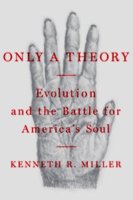 Only a Theory, by Kenneth R. Miller, springs from the federal trial in 2005, when creationism/ID lost its bid to become part of the public school curriculum in Dover, Pennsylvania. Miller links that case to a "broader assault on scientific reason" that he believes to be underway. But before opening that discussion he must rebut, once again, claims that Darwinism is not a sufficient scientific explanation of evolution. This rebuttal interests us.
Only a Theory, by Kenneth R. Miller, springs from the federal trial in 2005, when creationism/ID lost its bid to become part of the public school curriculum in Dover, Pennsylvania. Miller links that case to a "broader assault on scientific reason" that he believes to be underway. But before opening that discussion he must rebut, once again, claims that Darwinism is not a sufficient scientific explanation of evolution. This rebuttal interests us.
As many do, Miller exploits the ambiguous meaning of "evolution." He cites (a) the history of life on Earth [which virtually everyone accepts] and (b) examples of adaptation or microevolution [which proponents of ID accept] in support of (c) the Darwinian mechanism behind macroevolutionary innovation [which is the main issue, for which a & b are barely relevant]. Fortunately, he also looks more closely at a few examples of Michael Behe's "irreducible complexity."
One of those examples is the evolution of the immune system in jawed vertebrates. For Behe it is too complex to have been composed by Darwinian mutation-and-natural-selection. Miller rebuts Behe by citing studies which ...reached their climax in 2005 when the exact transposon from which the immune system evolved was conclusively identified (p 73). Miller's reference for this climactic identification is an article by a pair of geneticists at the Genetic Research Information Institute in Mountain View CA, published online by PLoS Biology in June 2005. We have now studied that paper. Its abstract states:
|
The V(D)J recombination reaction in jawed vertebrates is catalyzed by the RAG1 and RAG2 proteins, which are believed to have emerged approximately 500 million years ago from transposon-encoded proteins. Here we show that the approximately 600-amino acid "core" region of RAG1 required for its catalytic activity is significantly similar to the transposase encoded by DNA transposons that belong to the Transib superfamily. This superfamily was discovered recently based on computational analysis of the fruit fly and African malaria mosquito genomes. Transib transposons also are present in the genomes of sea urchin, yellow fever mosquito, silkworm, dog hookworm, hydra, and soybean rust.... |
Miller thinks the perception of this scenario has elucidated the evolution of this key part of the immune system. Actually, the scenario affirms that the critical parts of the system were encoded by transposon-related genes that must have already existed in more primitive species lacking this kind of immune system. By some means of gene transfer, the jawed vertebrates acquired the genes. After acquisition, some assembly and optimization followed. Most of these facts have been known since 1998.
In no way does this evidence show that the needed genes incrementally "evolved" by darwinian mutation-and-natural-selection. Instead, they were already available before they were expressed. Thus, the scenario presents a jarring puzzle for darwinism: How could the essence of this genetic program come into being before it could be affected by natural selection? But darwinians ignore these logical gaps, hoping the rest of us will grow weary and welcome a change of subject.
Eventually Miller argues that creationism/ID's alternative for explaining complex genetic programs is not clear. We agree. We think both programs, darwinism and creationism/ID, are flawed. We wish a third alternative such as cosmic ancestry would get consideration.
 Kenneth R. Miller, Only a Theory: Evolution and the Battle for America's Soul, ISBN:9780670018833, Penguin Group (USA) Inc., 12 Jun 2008. Kenneth R. Miller, Only a Theory: Evolution and the Battle for America's Soul, ISBN:9780670018833, Penguin Group (USA) Inc., 12 Jun 2008.
 Vladimir V. Kapitonov and Jerzy Jurka, "RAG1 Core and V(D)J Recombination Signal Sequences Were Derived from Transib Transposons" [article], doi:10.1371/journal.pbio.0030181, v3 n6 e181, PLoS Biology, Jun 2005. Vladimir V. Kapitonov and Jerzy Jurka, "RAG1 Core and V(D)J Recombination Signal Sequences Were Derived from Transib Transposons" [article], doi:10.1371/journal.pbio.0030181, v3 n6 e181, PLoS Biology, Jun 2005.
 Andrea Bottaro et al., "Immunology in the spotlight at the Dover 'Intelligent Design' trial" [article], doi:10.1038/ni0506-433, p 433-435 v 7, Nature Immunology, May 2006. Andrea Bottaro et al., "Immunology in the spotlight at the Dover 'Intelligent Design' trial" [article], doi:10.1038/ni0506-433, p 433-435 v 7, Nature Immunology, May 2006.
 Viruses... is the main CA webpage about HGT [ Viruses... is the main CA webpage about HGT [ What'sNEW about HGT What'sNEW about HGT  ] ]
 Evolution versus Creationism is a related CA webpage. Evolution versus Creationism is a related CA webpage.
 ...A Third Alternative by Klyce and Wickramasinghe, is a related CA reprint. ...A Third Alternative by Klyce and Wickramasinghe, is a related CA reprint.
 Comparing Darwinism, Creationism/ID and Cosmic Ancestry is a related CA webpage. Comparing Darwinism, Creationism/ID and Cosmic Ancestry is a related CA webpage.
 18 Jun 2007: Michael Behe's The Edge of Evolution is reviewed. 18 Jun 2007: Michael Behe's The Edge of Evolution is reviewed.
 19 Oct 2005: Michael Behe testified in a lawsuit in Dover PA. 19 Oct 2005: Michael Behe testified in a lawsuit in Dover PA.
 25 Aug 1998: We owe the repertoire of our immune system to one transposon insertion 450 million years ago. 25 Aug 1998: We owe the repertoire of our immune system to one transposon insertion 450 million years ago.
 30 October 2008 30 October 2008
Horizontal transfer (HT) of DNA transposons has apparently produced evolutionary innovation in mammals, according to biologists at the University of Texas, Arlington. This is believed to be the first "unequivocal evidence for the repeated HT of a DNA transposon" into tetrapods, including 5 mammalian orders. The transposon family, named SPACE INVADERS (SPIN), has a spotty distribution pattern among species, unsimilar placement within different genomes, and a very high level of conservation. Together these facts indicate that horizontal transfer is the likeliest means of acquisition.

- "The only plausible scenario is that active and nearly identical SPIN elements were introduced horizontally, and relatively recently, into several tetrapod species and subsequently spawned different waves of SPIN amplification along these species lineages.
- "There is little doubt that SPIN amplification not only added megabases of DNA to the genomes, but it also promoted lineage-specific changes in chromosomal architecture and fueled evolutionary innovation.
- "Despite ...outstanding questions, our data provide evidence that HT has contributed significantly to diversifying and shaping the genomes of mammals and other tetrapods.
- "These findings are startling given the barriers apparently opposing the entry of exogenous DNA into the sequestered germline of animals."
Various other methods of horizontal transfer of genetic material are already known to have important evolutionary effects among eukaryotes. With a striking example, the horizontal transfer of DNA transposons is added to the list.
| This is a remarkable and unexpected finding, because it suggests that the ancestors of these species, some of which occupied different continents, were infiltrated by the same transposon at roughly the same time — Damon Lisch |
Elsewhere we have written, "If a new genetic program arrives by the strong panspermia process, intervening species should possess either nearly identical versions of it ...or nothing similar." The data in this study are consistent with that supposition.
 John K. Pace II et al., "Repeated horizontal transfer of a DNA transposon in mammals and other tetrapods" [abstract], doi:10.1073/pnas.0806548105, p 17023-17028 v 105, Proc. Natl. Acad. Sci. USA, 4 Nov (online 20 Oct) 2008. John K. Pace II et al., "Repeated horizontal transfer of a DNA transposon in mammals and other tetrapods" [abstract], doi:10.1073/pnas.0806548105, p 17023-17028 v 105, Proc. Natl. Acad. Sci. USA, 4 Nov (online 20 Oct) 2008.
 Damon Lisch, "A new SPIN on horizontal transfer" [extract], doi:10.1073/pnas.0809525105, p 16827-16828 v 105, Proc. Natl. Acad. Sci. USA, 4 Nov (online 30 Oct) 2008. Damon Lisch, "A new SPIN on horizontal transfer" [extract], doi:10.1073/pnas.0809525105, p 16827-16828 v 105, Proc. Natl. Acad. Sci. USA, 4 Nov (online 30 Oct) 2008.
 'Space invader' DNA infiltrated mammalian genomes, by Jessica Griggs, NewScientist.com news service, 20 Oct 2008. 'Space invader' DNA infiltrated mammalian genomes, by Jessica Griggs, NewScientist.com news service, 20 Oct 2008.
 Viruses... is the main CA webpage about HGT [ Viruses... is the main CA webpage about HGT [ What'sNEW about HGT What'sNEW about HGT  ] ]
 New genetic programs in Darwinism and strong panspermia is the CA webpage containing our sentence quoted above. New genetic programs in Darwinism and strong panspermia is the CA webpage containing our sentence quoted above.
 Thanks, Cédric Feschotte, who says, It's like a pandemic... that can infect species that weren't genetically or geographically close. Thanks, Cédric Feschotte, who says, It's like a pandemic... that can infect species that weren't genetically or geographically close.
 Cédric Feschotte sends further comments, 4 Feb 2009. Cédric Feschotte sends further comments, 4 Feb 2009.
 25 October 2008 25 October 2008
On Mars, plumes of methane hundreds of kilometres across bloom and dissipate in less than a year. With methane concentrations reaching 60 parts per billion, the volume of methane appearing and vanishing so quickly in these hotspots must come from a powerful source. Apparently, methane on Mars is produced several orders of magnitude faster than previously suspected. Now NASA is asking: could methanogenic bacteria be the source?

The analysis of the short-lived plumes comes from a team led by Michael Mumma (pictured), of NASA's Goddard Space Flight Center in Greenbelt, Maryland. It was presented at a meeting of the American Astronomical Society in Ithaca, New York, 11 October.
 Plumes of methane identified on Mars, by Eric Hand, NatureNews, 21 Oct 2008. Plumes of methane identified on Mars, by Eric Hand, NatureNews, 21 Oct 2008.
 Life on Mars is a related CA webpage. Search for "methane". Life on Mars is a related CA webpage. Search for "methane".
 Methane plumes on Mars may come from life, 16 Jan 2009. Methane plumes on Mars may come from life, 16 Jan 2009.
 21 October 2008 21 October 2008
Hundreds of genes from bacteria are found in diatom genomes. An international team reports —
- Horizontal gene transfer between bacteria and diatoms is pervasive....
- Bacterial genes in diatoms do not appear to be derived from any one specific source, but from a range of origins....
- Many of the genes shared between diatoms and bacteria encode components that are likely to provide novel metabolic capacities, ...novel cell wall components, and to provide unorthodox mechanisms of DNA replication, repair and recombination for a eukaryotic cell.
- We therefore propose that gene transfer from bacteria to diatoms, and perhaps vice versa, has been a common event in marine environments and has been a major driving force during diatom evolution.

 Chris Bowler et al., "The Phaeodactylum genome reveals the evolutionary history of diatom genomes" [abstract], doi:10.1038/nature07410, p 239-244 v 456, Nature, 13 Nov (online 15 Oct) 2008. Chris Bowler et al., "The Phaeodactylum genome reveals the evolutionary history of diatom genomes" [abstract], doi:10.1038/nature07410, p 239-244 v 456, Nature, 13 Nov (online 15 Oct) 2008.
 Ronald P. Kiene, "...Genes in the glass house" [html], doi:10.1038/456179a, p 179-181 v 456, Nature, 13 Nov 2008. Ronald P. Kiene, "...Genes in the glass house" [html], doi:10.1038/456179a, p 179-181 v 456, Nature, 13 Nov 2008.
 Viruses... is the main CA webpage about HGT [ Viruses... is the main CA webpage about HGT [ What'sNEW about HGT What'sNEW about HGT  ] ]
 20 October 2008 20 October 2008
Residue from one of Stanley Miller's experiments in 1953-54 has been found to contain all 20 of life's amino acids. After Miller died in 2007, two of his former students, James Cleaves and Jeffrey Bada, recovered his vials and lab notes and undertook the analysis.
| 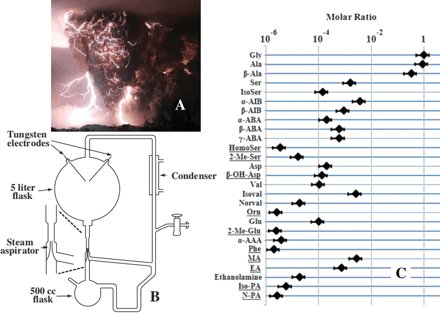
A: Volcanic plume with lightning. B: The experimental setup that might simulate this environment. C: Amino acids and concentrations detected. |
Miller originally used three different setups for his experiments. The famous classic setup used a spark discharge aparatus. Another setup (see diagram) added a steam aspirator to increase the gas flow rate through the system. None of the three setups produced detectable quantities of more than half of life's 20 amino acids. But with today's state-of-the-art instruments, analysts at the Goddard Astrobiology Analytical lab could detect much lower concentrations than Miller could. In residue from the spark discharge setup with a steam aspirator, all 20 are detectable today.
Miller's origin-of-life experiments were staged in a highly reducing atmosphere, as the early Earth was assumed to possess. That assumption is no longer accepted, a reversal that reduces the impact of the original experiments. But the spark discharge setup with a steam aspirator "possibly simulates the spark discharge synthesis by lightning in a steam-rich volcanic eruption." Such an environment might produce, locally and briefly, the assumed reducing atmosphere. This possibility has led to the new suggestion that life may have gotten its starter ingredients in a lightning-riddled volcanic plume.
Even if life's 20 amino acids could be created in volcanic plumes, tremendous problems would remain for the hardware aspect of the origin-of-life problem. And the seldom-mentioned software aspect of the problem is even more difficult. But speculation continues unabated.
 Adam P. Johnson et al., "The Miller Volcanic Spark Discharge Experiment" [abstract], doi:10.1126/science.1161527, p 404 v 322, Science, 17 Oct 2008. Adam P. Johnson et al., "The Miller Volcanic Spark Discharge Experiment" [abstract], doi:10.1126/science.1161527, p 404 v 322, Science, 17 Oct 2008.
 Did Volcanoes Spark Life on Earth?, by Phil Berardelli, ScienceNOW Daily News, 16 Oct 2008. Did Volcanoes Spark Life on Earth?, by Phil Berardelli, ScienceNOW Daily News, 16 Oct 2008.
 Volcanoes May Have Provided Sparks and Chemistry for First Life, by Bill Steigerwald, NASA Goddard Space Flight Center, 16 Oct 2008. Volcanoes May Have Provided Sparks and Chemistry for First Life, by Bill Steigerwald, NASA Goddard Space Flight Center, 16 Oct 2008.
 Volcanoes May Have Provided Sparks of First Life, Scripps Institution of Oceanography, University of California, San Diego, 16 Oct 2008. Volcanoes May Have Provided Sparks of First Life, Scripps Institution of Oceanography, University of California, San Diego, 16 Oct 2008.
 'Lost' Miller-Urey experiment created more of life's building blocks, Indiana University, 16 Oct 2008. 'Lost' Miller-Urey experiment created more of life's building blocks, Indiana University, 16 Oct 2008.
 The RNA World is the main CA webpage about origin-of-life theories, with links to more about Miller. The RNA World is the main CA webpage about origin-of-life theories, with links to more about Miller.
 Thanks, Stan Franklin and Newswise.com. Thanks, Stan Franklin and Newswise.com.
 11 October 2008 11 October 2008
A short video about pseudo-panspermia from The Learning Channel is online. In three minutes, NASA's Chris McKay, Dave Deamer of the University of California at Santa Cruz, and astrobiologist Christopher Chyba promote the delivery of the ingredients for life to Earth by asteroids or comets. "But what of the blueprint – the recipe...?," the narrator asks. For the software aspect of the origin-of-life, Chyba is appropriately humble: "...An almost overwhelming kind of step."

 It Came From Outer Space: Panspermia, Howstuffworks.com, n.d. It Came From Outer Space: Panspermia, Howstuffworks.com, n.d.
 Modern Panspermia, a section of CA's webpage Panspermia Asks New Questions, explains pseudo- and other versions of panspermia. Modern Panspermia, a section of CA's webpage Panspermia Asks New Questions, explains pseudo- and other versions of panspermia.
 Three YouTube videos about panspermia are linked from What'sNEW, 22 Apr 2008 Three YouTube videos about panspermia are linked from What'sNEW, 22 Apr 2008
 The RNA World is our main webpage about origin-of-life theories. The RNA World is our main webpage about origin-of-life theories.
 Thanks, Google Alerts. Thanks, Google Alerts.
 9 October 2008 9 October 2008
Three more early works by Fred Hoyle and Chandra Wickramasinghe can now be downloaded in full for free from the Buckingham Centre for Astrobiology (BCAB) and from this website, via links at far right. The PDF pages are scanned images.
 Fred Hoyle and Chandra Wickramasinghe, Living Comets, University College Cardiff Press, 1985. (Local PDF) Fred Hoyle and Chandra Wickramasinghe, Living Comets, University College Cardiff Press, 1985. (Local PDF)
 Fred Hoyle, Chandra Wickramasinghe and John Watkins, Viruses from Space, University College Cardiff Press, 1986. (Local PDF) Fred Hoyle, Chandra Wickramasinghe and John Watkins, Viruses from Space, University College Cardiff Press, 1986. (Local PDF)
 Fred Hoyle and Chandra Wickramasinghe, Space Travellers: The Bringers of Life, University College Cardiff Press, 1981. (Local PDF) Fred Hoyle and Chandra Wickramasinghe, Space Travellers: The Bringers of Life, University College Cardiff Press, 1981. (Local PDF)
 Hoyle and Wickramasinghe's Analysis of Interstellar Dust is a related CA webpage with a list of Selected Resources. Hoyle and Wickramasinghe's Analysis of Interstellar Dust is a related CA webpage with a list of Selected Resources.
 Proofs That Life Is Cosmic by Hoyle and Wickramasinghe is also available for download, 26 Aug 2008. Proofs That Life Is Cosmic by Hoyle and Wickramasinghe is also available for download, 26 Aug 2008.
|

 Our research is much like studying the etymology of modern languages so as to reveal fundamental things about their evolution. ...We identified common genetic traits between animals, plant, bacteria, and used them to create a tree of life with branches representing separate species. These all stemmed from the same trunk – LUCA, the genetic makeup that we then further characterized, says research team member Nicolas Lartillot.
Our research is much like studying the etymology of modern languages so as to reveal fundamental things about their evolution. ...We identified common genetic traits between animals, plant, bacteria, and used them to create a tree of life with branches representing separate species. These all stemmed from the same trunk – LUCA, the genetic makeup that we then further characterized, says research team member Nicolas Lartillot.
 How ancient organic molecules came together to form the basis of life — According to a press release, this is the issue illuminated by recent research with RNA molecules at the Department of Genetics and Molecular Biology, Sapienza University of Rome, Italy. A team there showed that under certain conditions RNA molecules could be induced to grow longer than they normally do in solution. Obtaining strands of RNA nucleotides long enough to have any biological function is one of the difficulties for "RNA World" versions of origin-of-life theories. If that difficulty can be overcome, RNA strands long enough to fold might happen to acquire enzymatic properties, the Italians suppose.
How ancient organic molecules came together to form the basis of life — According to a press release, this is the issue illuminated by recent research with RNA molecules at the Department of Genetics and Molecular Biology, Sapienza University of Rome, Italy. A team there showed that under certain conditions RNA molecules could be induced to grow longer than they normally do in solution. Obtaining strands of RNA nucleotides long enough to have any biological function is one of the difficulties for "RNA World" versions of origin-of-life theories. If that difficulty can be overcome, RNA strands long enough to fold might happen to acquire enzymatic properties, the Italians suppose.
 Organic compounds can also be a by-product of life processes and their detection on an Earth-like planet may someday provide the first evidence of life beyond Earth. These comments come from the science team operating the Hubble Space Telescope, whose recent observations include the detection of methane and carbon dioxide in the atmosphere of an extra-solar planet designated HD 189733b. We are pleased by the acknowledgement that organic compounds beyond Earth may be post-biotic, a possibility usually ignored. Organic compounds in space have been well-known for decades now. Could the "first evidence" already be in hand? Meanwhile, another team, using NASA's Spitzer Space Telescope, has seen water vapor on the same planet.
Organic compounds can also be a by-product of life processes and their detection on an Earth-like planet may someday provide the first evidence of life beyond Earth. These comments come from the science team operating the Hubble Space Telescope, whose recent observations include the detection of methane and carbon dioxide in the atmosphere of an extra-solar planet designated HD 189733b. We are pleased by the acknowledgement that organic compounds beyond Earth may be post-biotic, a possibility usually ignored. Organic compounds in space have been well-known for decades now. Could the "first evidence" already be in hand? Meanwhile, another team, using NASA's Spitzer Space Telescope, has seen water vapor on the same planet. Glycolaldehyde 26,000 light-years away has been detected by European astronomers using the IRAM radio dish array in France. Glycolaldehyde is a simple sugar that makes up ribose, one of the constituents of RNA. Finding it in a coalescing disk of dust and gas in a star-forming region of space was a surprise. "The sugar molecule can apparently form in a simple reaction between carbon monoxide molecules and dust grains," reports Phil Berardelli in Science. This is especially interesting, he adds, because the phenomenon was observed "far away from the radiation-filled center of the Milky Way, so if any biological processes start up there, they will have a chance to establish themselves."
Glycolaldehyde 26,000 light-years away has been detected by European astronomers using the IRAM radio dish array in France. Glycolaldehyde is a simple sugar that makes up ribose, one of the constituents of RNA. Finding it in a coalescing disk of dust and gas in a star-forming region of space was a surprise. "The sugar molecule can apparently form in a simple reaction between carbon monoxide molecules and dust grains," reports Phil Berardelli in Science. This is especially interesting, he adds, because the phenomenon was observed "far away from the radiation-filled center of the Milky Way, so if any biological processes start up there, they will have a chance to establish themselves."

 Life has a role in the origin of minerals according to geophysicist Robert Hazen of the Carnegie Institution. Thousands of minerals can form only in special environments that are produced by life. Many of them, like azurite and malachite, require an oxygen-rich atmosphere. Of the approximately 4,300 known mineral species on Earth, perhaps two thirds of them are biologically mediated. This is principally a consequence of our oxygen-rich atmosphere, which is a product of photosynthesis by microscopic algae, Hazen's team reports.
Life has a role in the origin of minerals according to geophysicist Robert Hazen of the Carnegie Institution. Thousands of minerals can form only in special environments that are produced by life. Many of them, like azurite and malachite, require an oxygen-rich atmosphere. Of the approximately 4,300 known mineral species on Earth, perhaps two thirds of them are biologically mediated. This is principally a consequence of our oxygen-rich atmosphere, which is a product of photosynthesis by microscopic algae, Hazen's team reports.
 ...Borrowing a couple of genes.... challenges the notion that higher organisms must rely on their own genes to evolve. These comments follow an investigation asking how a hybrid of the British common groundsel weed (pictured) came to have its large yellow petals (right). The international team determined that the change was initiated when the groundsel's ancestor acquired a cluster of regulatory genes from a Sicilian species introduced some 300 years ago. The transfer likely resulted from cross-pollenation. The biologists write, Our results ...show how gene transfers between species may play an important part in the evolution of key ecological and morphological traits.
...Borrowing a couple of genes.... challenges the notion that higher organisms must rely on their own genes to evolve. These comments follow an investigation asking how a hybrid of the British common groundsel weed (pictured) came to have its large yellow petals (right). The international team determined that the change was initiated when the groundsel's ancestor acquired a cluster of regulatory genes from a Sicilian species introduced some 300 years ago. The transfer likely resulted from cross-pollenation. The biologists write, Our results ...show how gene transfers between species may play an important part in the evolution of key ecological and morphological traits.
 Only a Theory, by Kenneth R. Miller, springs from the federal trial in 2005, when creationism/ID lost its bid to become part of the public school curriculum in Dover, Pennsylvania. Miller links that case to a "broader assault on scientific reason" that he believes to be underway. But before opening that discussion he must rebut, once again, claims that Darwinism is not a sufficient scientific explanation of evolution. This rebuttal interests us.
Only a Theory, by Kenneth R. Miller, springs from the federal trial in 2005, when creationism/ID lost its bid to become part of the public school curriculum in Dover, Pennsylvania. Miller links that case to a "broader assault on scientific reason" that he believes to be underway. But before opening that discussion he must rebut, once again, claims that Darwinism is not a sufficient scientific explanation of evolution. This rebuttal interests us.




